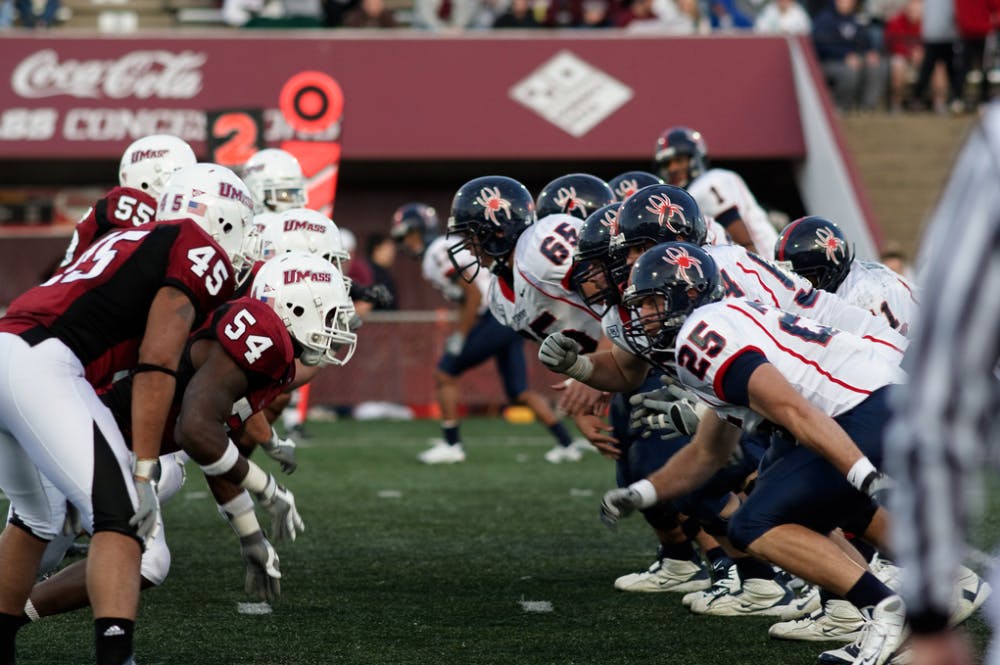The University of Richmond community gathered on April 21 to remember Kurt Schmitz, a former Richmond football player who died at the age of 22 this past November. Although there is still no official cause of Schmitz’s death, his brain has been donated to the Sports Legacy Institute, which conducts neuropathological studies of athletes’ brains.
Sunday also marked the three-year anniversary of the suicide of Ray Easterling, a former NFL safety and Richmond standout who suffered from depression and dementia due to his football career. Yet as the Spiders took the field for their annual spring football game on Saturday, Richmond football players still lacked a full education on the dangerous, long-term and permanent effects football can wreak on the brain. These are the issues that plagued Ray Easterling and led Kurt Schmitz to give up football.
Schmitz’s memorial offers a timely opportunity to examine how the University of Richmond's football team is educated on the connection between football and brain trauma.

Chronic Traumatic Encephalopathy, or CTE, is a degenerative brain disorder that has been linked to repeated blows to the head, specifically in football. First discovered in 2002, CTE can lead to early-onset dementia, Alzheimer’s and depression and has manifested in players as young as 17 years old.
Multiple former players have suffered irrational behavior, violent mood swings and crippling depression due to CTE in the years after retiring from football. Mike Webster, former Pittsburgh Steelers center and stalwart of four championship teams in the 1970s, was the first player diagnosed with CTE. He suffered from brain damage so severely after retiring that he routinely super glued his teeth back in after they’d fallen out, and would tase himself to fall asleep at night.
Easterling suffered such bad paranoia that he once hid in a driveway for hours during his daily run because he thought he was being followed. He lost the ability to control his temper and became prone to flashes of rage. CTE was found in Easterling’s brain, too.
“Our brain is kind of like a bank, and when we injure it we’re using the reserve,” said Chris Jones, Richmond’s sports medicine director. “If we use all the reserve up, and our brain already deteriorates throughout our life, if we use too much of that reserve in our youth it gets challenging when we get older.”
 Richmond football players are well-informed on techniques to prevent concussions and repeatedly told to report head injuries. But the damaging long-term effects of concussions, such as those suffered by Easterling and Webster, are still not communicated to the football team. As a consequence, many players remain ignorant to the potential ramifications football may incur.
Richmond football players are well-informed on techniques to prevent concussions and repeatedly told to report head injuries. But the damaging long-term effects of concussions, such as those suffered by Easterling and Webster, are still not communicated to the football team. As a consequence, many players remain ignorant to the potential ramifications football may incur.
“Pretty much all I know about it is if you get a concussion you’re supposed to let someone know,” Richmond captain Aaron Roane told the Collegian in November. “I never really think about concussions.”
Omar Howard, a Richmond linebacker, said his high school in Midlothian, Virginia, educated him more on the long-term effect of concussions than University of Richmond did, where nothing on long-term brain damage was specifically communicated.
Enjoy what you're reading?
Signup for our newsletter
“Probably most players on the team don’t really care, because they don’t know enough to care," Howard said. “It’s like their ignorance is bliss. If you don’t have to worry about it you’re not gonna worry about it.”
The lack of education players receive on the potential long-term damage begs the question of whether Richmond football players can make informed decisions before deciding to play football.
Winston Craig and Brandon Waller, both defensive linemen for the Spiders, agree that a certain level of ignorance is necessary to be the best football player you can be. “In the sport that we play, if you play timid, that’s when you’re gonna get (hurt),” Craig said.
Although some players may feel ignorance is necessary to on-field success, the players do not have agency over the knowledge they are given. The training staff -- not the players -- decides that the long-term dangers should not be communicated to the team.
Chris Jones, who also serves as Richmond’s head athletic football trainer, said he thought it was best not to over-complicate the education the players receive. “You’ve gotta speak to your audience in terms they can understand,” he said. “Talking about CTE and things like that, that might be too complex."
“A lot of them are very smart individuals, but for a large audience, the key is educating them about how they can identify if they have a concussion so they self report.”
Athletic Director Keith Gill said he supported Jones, but Jones’ strategy seems to contradict Gill’s stance on player education.
“I think that we should try to provide people with as much information as we can, and about all the injuries,” Gill said. “Anything you can do to encourage reporting is a good thing.”

By deciding on behalf of players what information is relevant to their futures, Richmond’s training staff does not provide the opportunity to make an informed decision and allows players to dwell in ignorance of the potentially devastating effects of repeated blows to the head.
Mary Ann Easterling, Ray’s widow and one of the lead plaintiffs in a billion-dollar lawsuit against the NFL about head injuries, compared withholding the long-term dangers of football with withholding the cancerous effects of smoking cigarettes.
“I think (players) need to hear the whole story,” Mary Ann said. “They need to hear the case studies, the worst case scenarios. They need to know what could happen. They deserve to know that.”
In the beginning of the school year, Jones conducts meetings with all student-athletes discussing medical policies and procedures that include preventative concussion measures and the risks of returning too soon from head injuries. Before the season, cognitive baseline tests are conducted on every Richmond athlete, and they all sign a form pledging that they will truthfully report their injuries. The Athletic Department also consults an independent neurologist with no vested interest in University of Richmond athletics.
Despite all of the preventative measures the department puts players through, the long-term effects from concussions are not discussed with players until after they have been concussed. This sequence is better for players with head injuries, Jones said.
Jones also said it may not be appropriate to share the long-term effects with each player because those effects are not completely understood.
“The hard thing about all these different things you read in the media is that we’re still trying to find out why certain individuals develop CTE and have these problems and why some play contact sports for a number of years and they don’t have these problems,” Jones said. “It is hard to say every person who plays in sports will develop CTE or have a long-term brain problem.”
Because the knowledge surrounding CTE is not definitive, Jones said providing information on the disease to every player would just be a scare tactic to frighten players into reporting head injuries. He does not condone that method.
Waller was supportive of Jones and the training staff. “They definitely do a good job of keeping us informed of everything they think is conclusive,” Waller said.
Easterling agrees the information surrounding CTE is incomplete, but she said that was still no excuse for the players to lack awareness. She also said that having knowledge of the potential long-term effects of head injuries was foundational to making an informed decision to play football.
“There is a lot we still have to learn,” Mary Ann said. “But, if you want to pretend you’re not going to be affected by it, it’s going to be your loss and your surprise when your brain starts to deteriorate at 51. Or like with Ray, when you start having behavioral and mood problems.”
Even players who are well-informed on the potential long-term impact are divided on the issue.
Chris Borland, a former San Francisco 49ers linebacker, retired from football this year after one NFL season because of fears of the long-term impact of head injuries.
"...When you read about Mike Webster and Dave Duerson and Ray Easterling… To be the type of player I want to be in football, I think I'd have to take on some risks that, as a person, I don't want to take on,” Borland told Outside the Lines.

Waller showed similar sentiment, saying that long-term brain damage “absolutely” scared him, and that if he ever has a son he would prefer him to play golf. Craig, on the other hand, is willing to sacrifice the long-term health of his brain for a fruitful football career that will allow him to support his family.
Regardless of their personal choices, Craig, Howard and Waller all said that Richmond’s football program could do a better job of educating its players to help them make informed decisions.
In Easterling’s eyes, University of Richmond’s current system is upsettingly insufficient. “It makes me very sad, that the university that I went to is not interested in completely educating their football players,” she said.
The memorial service for Kurt Schmitz was held in Cannon Memorial Chapel on Sunday, April 19 at 2 p.m.
The cause of Schmitz’s death is unknown at this time. Schmitz hid three concussions from the Richmond training staff before suffering a fourth that ended his football career. He spent the rest of his time at Richmond encouraging teammates to report their concussions rather than hide them.
"Guys on the team aren't superman," Schmitz told the Collegian in April 2014. "You may want to play through days where you can't see straight, but from what I've experienced, it will catch you."
Contact Sports Editor Charlie Broaddus at charlie.broaddus@richmond.edu or Features Assistant Danny Heifetz at danny.heifetz@richmond.edu
Support independent student media
You can make a tax-deductible donation by clicking the button below, which takes you to our secure PayPal account. The page is set up to receive contributions in whatever amount you designate. We look forward to using the money we raise to further our mission of providing honest and accurate information to students, faculty, staff, alumni and others in the general public.
Donate Now



